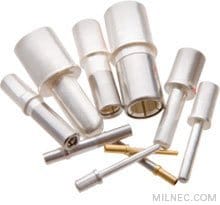The Heart of a Connector

Crimp Versus Solder
Both crimp and solder termination methods provide effective connections between wire conductors and contacts. Crimp termination is preferred for high-performance applications and has many advantages over solder for improved installation speed, consistency, and reliability. In addition, crimp contacts can be removed and replaced while solder contacts cannot. Solder termination, however, remains a reliable and cost-effective option for general duty applications because no specialized tooling is required. Depending on the level of performance, one termination method might be more suitable than another for your particular application and budget requirements.
Crimp Contacts
Crimping is the act of joining a wire to a contact using a crimp tool that ensures a simple, fast, and precise termination every time. During crimping, the contact barrel is compressed on to the wire to mechanically bond the contact and conductor (solid core or stranded wire) together. Crimp termination offers the highest reliability, and is the preferred method for high-performance military and aerospace applications because it permits higher contact densities, ease of installation, and increased reliability over solder termination. Because crimp contacts are removable, damaged pins can be individually replaced without sacrificing the connector. This process is known as “re-pinning.” Milnec’s BC and TC Series of connectors feature crimp contacts.

Solder Contacts
Soldering is the traditional and most cost-effective method of wire termination. The soldering process involves melting and cooling a lead or tin alloy into solder cups to bond a wire conductor (either solid core or stranded) to a contact. Soldering is a reliable method of termination for general duty applications. No special tooling is needed, and nearly any size wire and solder contact can be terminated with a basic soldering kit. Milnec’s HS and PS Series feature solder contacts that are precision-machined from copper alloys, which provide increased conductivity. They are plated with gold or silver alloy, depending on the series, to enhance corrosion resistance and further decrease contact resistance. However, because solder contacts are permanently bonded to the inserts, they are non-removable and non-repairable. Should a contact become damaged as result of corrosion or impact, the entire connector must be replaced.
PC Tail Contacts
PC tail contacts (also referred to as PCB or spill contacts) are used exclusively for connectors that are mounted directly to printed circuit boards or flex cable by a specialized contact with a long termination “tail” that protrudes behind the connector body. PC tail contacts offer a number of design advantages by permitting the use of ruggedized connectors mounted to sophisticated electronics without the use of pigtails or bulky terminal blocks. Direct termination of contacts to PC boards also increases signal integrity and improves overall system reliability.
PC tail contacts differ from one another by the tail diameter and length. The tail length is the portion that extends beyond the main body of the contact and protrudes from the rear of the connector shell. In cases where the tail length extends beyond a design’s required minimum length, excess tail material can simply be trimmed with wire cutters after soldering and testing. Milnec also offers custom coax, twinax, or quadrax PC tail contacts to accommodate high-frequency contact requirements.

RF Contacts (Coax, Twinax, Quadrax)
Coaxial contacts are used in a wide range of military and aerospace connectors for analog radio frequency or microwave applications. Coaxial contacts are specified according to the contact size, cable selection, and impedance. The contacts are interchangeable with standard 8, 12 and 16 size contacts, enabling the use of high-frequency contacts into standard mil-spec connectors.
Contact Sizes | ||||
| #20 Gold Plated |  |  | ||
| #16 Gold Plated |  |  | ||
| #16 Silver Plated |  |  | ||
| #12 Silver Plated |  |  | ||
| #8 Silver Plated |  |  | ||
| #4 Silver Plated |  |  | ||
| #0 Silver Plated |  |  | ||
| Contacts can vary greatly in size, depending on application demands. | ||||




